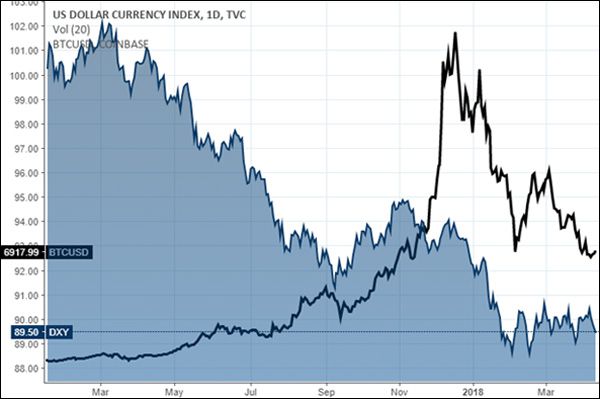At first sight, the relationship between Bitcoin and the US dollar seems fairly obvious. Bitcoin is designed to serve (1) as a means of payment, (2) as a decentralized ledger for recording assets and liabilities, and (3) as a store of value. Based on Bitcoin’s underlying design, its proponents claim that it is “money”. As a result, one would expect the cryptocurrency and the buck to behave in a similar fashion.
Yet Bitcoin behaves almost nothing like the US dollar, suggesting that its relationship with the world’s leading fiat currency is not that straightforward. While Bitcoin was designed to be money, we argue that the cryptocurrency is best described as a technology venture with significant promise but limited traction as “money”. While Bitcoin enthusiasts believe that the cryptocurrency has clear benefits over the US dollar, it has failed to gain enough commercial traction to trade like money. Similar to other technology ventures, Bitcoin tends to trade inversely to the US dollar.
The US dollar is the world’s reserve currency
Thanks to the phenomenon of globalization, both international trade and cross-border financial investments are commonplace today. As more and more business and investment activity becomes international, there is an obvious need for a single benchmark to compare prices across countries. As the world’s reserve currency, the US dollar is essentially the world’s monetary yardstick. A recent bulletin published by the Bank of England provides a good summary for the US dollar’s global role.
Major assets (such as commodities) are primarily traded against the US dollar, while the vast majority of international trade is conducted in the dollar. This is true even for two parties who do not transact domestically in the US dollar (for example: a Swedish buyer paying for a Japanese automobile). As described above, the US dollar is used in such a situation given the need for an independent measure of prices.
Beyond its role as a monetary yardstick, the dollar is a global safe haven
While the buck is the most used currency for making international payments, the majority of cross-border lending is also conducted in US dollars. This is because the US has some of the world’s deepest and most advanced capital markets. The dollar’s additional role as the world’s liability currency gives it the characteristics of a “safe haven” currency. When global economic growth is accelerating, borrowers seek US dollars (as bank loans or as debt securities) in order to fund future growth. As more and more dollars chase foreign investment opportunities, the dollar depreciates as a result. Given the significant cost of hedging dollar debt, many borrowers accept foreign exchange risk in order to raise financing.
The problem starts when global growth decelerates. Once economic conditions start worsening, foreign borrowers struggle to repay US dollar loans. At the same time, US dollar credit taps dry up as lenders begin to doubt the creditworthiness of borrowers. When borrowers struggle to repay their debt, they often sell their assets and buy US dollars to repay their loans. This causes a fire sale, and the US dollar surges relative to other currencies in response.
The fact that the dollar depreciates during a boom and appreciates during a bust makes the currency a classic safe haven asset. Unlike most other currencies, the dollar trades inversely to global risk sentiment. Most currencies do not trade like safe haven assets (as they are not used heavily for cross-border lending), and they are considered “risk-on” assets. “Risk-on” currencies appreciate when global growth is accelerating and depreciate during downturns. With the exception of the Japanese yen, the US dollar and the Swiss franc, all other currencies exhibit qualities of “risk-on” assets.
Bitcoin is a “risk-on” asset, but not a currency
As a whole, currencies tend to be less volatile relative to riskier financial assets such as equities or commodities. This is for a good reason: when currencies become excessively volatile (such as some emerging market currencies), the currency fails as a domestic monetary yardstick. This causes domestic trade and investment to slow fairly dramatically. If the value of the dollar swung 1% on a day-to-day basis, investors and businesspeople would reduce their dollar transactions and seek a more stable alternative currency.
While Bitcoin has enjoyed success as a speculative asset, it has mostly failed as “money”. Despite its strengths, the cryptocurrency suffers from many issues, including (1) high volatility, (2) unsolved security issues relating to storage, (3) the risk of technology obsolescence, (4) inefficient payment networks, and (5) limited usage as a means of payment and store of value.
High volatility means Bitcoin is more a technology venture than a currency
Today, Bitcoin’s rolling 30-day annualized volatility is north of 80% according to BitMEX, a leading cryptocurrency broker. By comparison, the NASDAQ’s rolling 30-day annualized volatility is under 30%. Note that the NASDAQ stock market index is considered a risky asset given the large number of technology stocks that trade on the exchange. The rolling 30-day annualized volatility of safer assets such as short-term government bonds is just 1%. Without pegging its value to a stable asset, Bitcoin has no chance today of competing against the US dollar today.
Instead of looking at Bitcoin as a currency, it makes more sense to look at the cryptocurrency as a technology startup. In 2017, the cryptocurrency soared in value thanks to (1) increasing payment volumes, (2) ideal economic conditions for growth-oriented investments, and (3) high hopes for the technology. In more recent times, cryptocurrency values have crashed as risk sentiment wanes while payment volumes have declined. A visual comparison of Bitcoin prices versus the US dollar index (a weighted measure of the USD against its major peers) is shown below:
As the dollar goes down (blue), Bitcoin goes up (black)

Source: MarketsNow, TradingView
As can be seen above, Bitcoin has moved in the opposite direction of the dollar in recent history. Following Bitcoin’s most recent downturn, the dollar has been trading sideways.
The US dollar and Bitcoin have a limited, inverse relationship
As Bitcoin is not a currency today, the asset ultimately has a very limited relationship with the US dollar. To the extent that the dollar is a safe haven currency and Bitcoin trades based on future expectations for the technology, Bitcoin and the dollar have an inverse trading relationship.


 Hot Features
Hot Features













